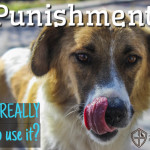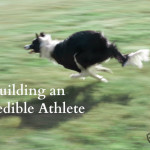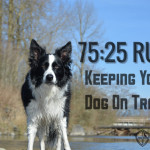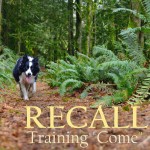Overcoming Reactivity
Re·ac·tive definition (Wikipedia): Showing a response to a stimulus, acting in response to a situation rather than creating or controlling it, having a tendency to react chemically.
Reactivity can happen in many different situations, such as when a dog is excited/happy, frustrated or fearful/defensive. Because the reactivity behaviour can be very similar in each scenario, this behaviour is often assessed improperly, leading to improper training techniques and no progress.
Why is reactivity so prominent in herding or working breeds? Because these dogs are meant to do something. These breeds are hard wired to work and to use their brain, but so often they overuse their brain - unfortunately, most of the time, this overuse happens in the wrong scenarios.
Growling, lunging, barking, snarling, snapping and hackles (piloerection) can be seen in all forms of reactivity:
- when a dog is excited and happy to see another person or dog
- frustrated when the dog hits the end of the leash and can’t go further, or if a dog is behind a gate/fence (barrier frustration)
- When a dog is scared of a person or dog they will act out defensively as to say “look at how big and tough I am, you better stay away”
- Don’t forget, plain jane communication. When a dog doesn’t like something the other dog is doing or saying, your dog may react with these same behaviours
So What Can You Do About Your Dog’s Reactivity?
ASSESSING PROPERLY
In order to work on lowering and extinguishing your dog’s reactivity, we have to know why the dog is reacting. Many owners will know without a doubt why their dog is reacting, but there are some cases where your dog’s behaviour is more complicated than you may think. These behaviours will need more sensitivity with training.
Ultimately, your dog is reacting for one of two reasons, or in more complex cases, both:
Distance Increasing: The dog wants the stimulus to go away; they are trying to scare the other dog or person off to gain more distance in between.
Distance Decreasing: This means the dog wants to get closer to the stimulus, often barking in excitement or frustration, sometimes just vocalizing.
SETTING YOUR DOG UP TO SUCCEED
MAKING TRAINING EASIER
Before you even plan on working with your dog on the problem behaviour, you MUST make sure you are fulfilling your dog’s basic needs.
Exercise – lack of exercise causes major frustration in dogs and can actually be a reason why some dogs act out aggressively.
Mental Enrichment – incredibly important for herding breeds. These dogs love to use their brain and problem solve (like most dogs), so it’s up to you to give them daily jobs and satiate that need.
Social Interaction – Dogs are social creatures and they need to have constant social contact everyday, otherwise they will be demanding it elsewhere.
Nutrition – Feeding your dog low quality kibble can have an effect on your dog’s behaviour. If you’re feeding them highly processed food that is filled with corn, the dog is going to have these bursts of energy from low quality carbs. Feeding your dog a whole food diet or even a high quality kibble will greatly help your training. But don’t expect miracles: it takes about three months to start noticing a change.
Equipment – Using the right equipment when working with a reactive dog can make a world of difference. Finding the right one for your dog may take some time and a few returns, but once you find the right fit, it makes your job for training much easier.
HALTI® Head Harness – This is used if you have a very strong puller or large dog. It gives us a little more control so the dog is constantly practicing bad behaviours (moving us towards the trigger and failing). Please keep in mind that your leash should always be shortened, but keep it slack. If the dog was to lunge with the full momentum of a 6 ft lead, he or she can injure themselves and your arm.
Freedom No Pull Harness – This body harness is absolutely wonderful for dogs that become frustrated or nervous, the pressure it taken off the neck (where accidental suffocation can take place and increase reactivity) and often dogs react better when put in a body harness. Of course there are some dogs who hate them, even when conditioned, so try it on and see how your dog likes it.
Leashes – Please only use a 4-8ft LEAD. No retractable leashes. Silky leashes are a wonderful tool to add to any owners tool box of training.
PLEASE DO NOT USE A PINCH, CHOKE, SHOCK OR SPRAY COLLAR ON YOUR DOG. THESE OFTEN MAKE WORSE PROBLEMS IN THE LONG RUN FOR YOU AND YOUR DOG. THEY ARE NOT NEEDED AND ARE HARMFUL TO YOUR DOG PHYSICALLY AND PSYCHOLOGICALLY.
TECHNIQUES & EXERCISES
Distance Increasing Reactivity (fearful, nervous dogs)
In order to change the exhibiting behaviour, we must change the underlying behaviour. Your dog wouldn’t be screaming for the stimuli to go away if he or she liked them, correct? Many trainers and owners want to focus solely on the exhibiting behaviour, but in actuality you need to fix the underlying problem, and get your dog feeling secure and safe so they won’t react any longer.
In order for us to work with this, we need to put a few exercises together. Generally these exercises should be used in conjunction with one another on your walks and set up scenarios (going to a location where you will see the trouble stimuli and working over and over for 30 minutes, a few times a week).
Changing Your Dog’s Perception with Counter-conditioning
- When your dog spots the “bad thing”, I want you to mark it “good dog” and simply feed your dog an extremely tasty human food treat (boiled chicken, steak, pepperoni, deli meat) - a very high value food.
(The only reason I like to use food instead of toys is that playing with your dog can amp them up more, causing more adrenaline to enter the system and this can backfire. I’ll usually use food until we start having no response when your dog is confronted with the stimuli then start incorporating a tug toy if your dog likes playing). - Once you’ve given the treat, I want you to walk backwards (away from the stimuli), while calling your dog in a happy tone (you don’t need to baby talk the dog, but just to entice the dog your way).
-
- If your dog follows, reward again
- If your dog doesn’t, start walking backwards, pulling your dog lightly, until he or she snaps into reality and follows you willingly, reward again.
- Continue walking away from the stimuli/trigger for a few minutes to give your dog that reinforcement (no scary trigger). Then start walking towards the next trigger.
Troubleshooting
It’s very common to see a dog that barks and reacts instantly when presented with the stimuli. That is okay; do the above training and try to give more distance if you’re finding the last distance your dog reacted to quickly. What you want to see is if your dog looks, pauses then possibly reacts, then this is a good distance. Some dogs will be 60 ft, 40ft or 20 ft before reacting; it’s up to you to find the threshold and work with your dog.
Distance Decreasing Reactivity (overly-excited dogs)
This is a vastly different approach, hence why you need to assess properly. Otherwise, you may run into problems.
Obedience Is Your Best Friend
Dogs that are over excited and react quickly upon the stimuli generally are lacking in impulse control. Impulse control is the mind saying “go for it” and the body follows instantly, rather than thinking and responding to a well known cue. Don’t forget these dogs are often accidentally rewarded for their bad behaviour: for example, you may find your dog pulling on the leash and you let them say hello, barking at the other dog . Eventually, you allow them to say hello because you want them to stop. As a result, the dog has actually trained you. Congrats, you have a very smart dog!
Tug Game – Practice playing tug with your dog on a regular basis, every day.
- Get a nice floppy toy such as the Chuck It Large Flying Squirrel (this is great for tug games, durable and flat for good gripping).
- Ask your dog to sit and look at you. If the dog complies, reward with the tug “Tug! Tug!” make your dog go NUTS! Get him or her growling and thrashing.
- When your dog is going nuts, ask the dog to “leave it” and stop moving the tug toy. Try to keep it very still so that the dog thinks you’ve stopped playing.
- If the dog slowly releases, encourage him with “good boy, leave it”. Once he or she lets go, ask for a sit and eye contact and go crazy again asking for “Tug! Tug!”
- If the dog doesn’t let go, try using a piece of food waved by his nose or wait him out until the dog lets go.
It sometimes takes the dog a few goes before realizing it’s awesome when letting go of the toy, cause the human gets super excited to play again. Always get that “leave it” and eye contact before tugging. Very important to your training.
Teach Your Dog a Stationary Stay – “you and I stand together and don’t move”
Practice with your dog on leash and on distractions that your dog doesn’t react to (use people if your dog is dog-dog reactive etc.)
- Stand next to your dog with a handful of treats that your dog LOVES more than life itself.
- Shorten the leash so it’s about 1 foot from your hand and the dog, but keep it slack!
- Ask your dog to “dog, stay”
- Reward every 3 count while the distraction is passing. If your dog breaks the stay before 3 seconds, go to 2 seconds or even every 1 second until you can build up the time
- After the distraction is gone, RELEASE your dog (VERY IMPORTANT STEP!) “okay dog, let’s go!”
Repeat this as much as you can in all different scenarios where things move around you but don’t cause your dog to flip out. If your dog flips out at everything then you will need to work on distance and threshold, starting with having your dog much further away from the triggers and with success, moving closer.
Two Weeks of Training Is Done – Next Step
Now that you have been working with your dog on the “stay” and “leave it with eye contact,” you’ll want to start incorporating them with your triggers. Remember that distance is your friend when working with reactivity.
How a situation should play out:
- You and your dog see the trigger coming up
- You guide your dog off to the side as much as you can to give some distance for when they pass
- When your dog spots it, ask him or her to “leave it” – if you’ve been playing this everyday, your dog will whip his or her head to you, possibly for only a split second but that is your turn to mark it “good dog” and reward instantly.
*Speed is crucial. That dog’s mind is racing and you need to match that speed to remain a high reinforcement, otherwise that dog will ignore you and focus on better things. - Once you’ve got the leave it, ask your dog to stay. Reward every few seconds. If the dog is focusing too much on the trigger(s), ask him or her to leave it again.
- Repeat these techniques over and over until the trigger is gone.
Troubleshooting
If the dog reacts (barks, lunges, etc.) you need to instantly walk away from the trigger. Doing so tells the dog that his or her behaviour just got them further away from what they want – a consequence to behaviour. Stop and try again once your dog is not reacting – reinforcement for behaviour.
If you have a leash frustrated dog, you want to avoid ANY tension on the leash – this is what creates the reactivity. So you need to have very good obedience cues in your pocket if your dog becomes frustrated on leash.
Article By:
Kris Crestejo, CDBC







